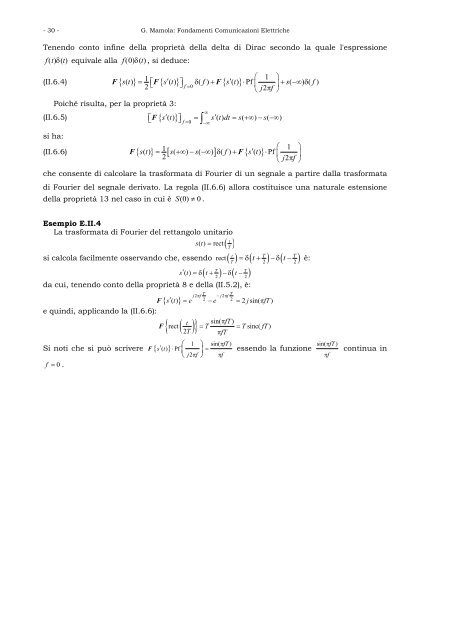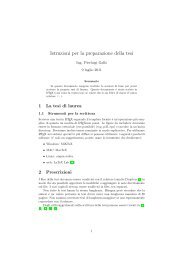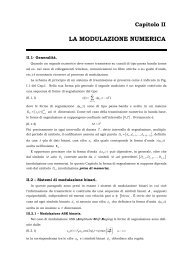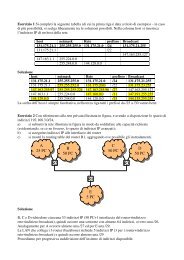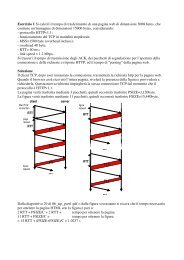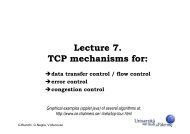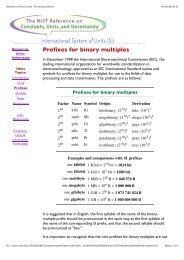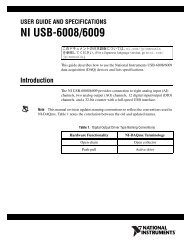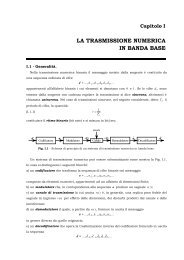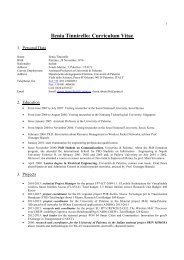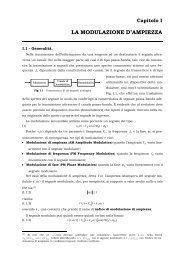Il dominio della frequenza
Il dominio della frequenza
Il dominio della frequenza
Create successful ePaper yourself
Turn your PDF publications into a flip-book with our unique Google optimized e-Paper software.
- 30 - G. Mamola: Fondamenti Comunicazioni Elettriche<br />
Tenendo conto infine <strong>della</strong> proprietà <strong>della</strong> delta di Dirac secondo la quale l'espressione<br />
f(t)δ(t)<br />
equivale alla<br />
f(0)δ(t) , si deduce:<br />
1<br />
⎛ 1 ⎞<br />
F s() t = ⎡ s () t ( f) s () t Pf s( ) ( )<br />
2 ⎣F ⎤⎦<br />
δ + F ⋅ + −<br />
f = 0<br />
⎜ ⎟ ∞ δ f<br />
⎝ j2πf<br />
⎠<br />
(II.6.4) { } { ′ } { ′ }<br />
Poiché risulta, per la proprietà 3:<br />
(II.6.5) ⎡F<br />
{ } ⎤<br />
f 0<br />
si ha:<br />
∞<br />
⎣ s′ () t ⎦ =<br />
∫<br />
s′<br />
() t dt = s( +∞) −s( −∞)<br />
= −∞<br />
1<br />
⎛ 1 ⎞<br />
() = ( +∞) − ( −∞) δ ( ) + () ⋅Pf<br />
2<br />
⎜ ⎟<br />
⎝ j2πf<br />
⎠<br />
(II.6.6) F{ st} [ s s ] f F { s′<br />
t}<br />
che consente di calcolare la trasformata di Fourier di un segnale a partire dalla trasformata<br />
di Fourier del segnale derivato. La regola (II.6.6) allora costituisce una naturale estensione<br />
<strong>della</strong> proprietà 13 nel caso in cui è S(0) ≠ 0 .<br />
Esempio E.II.4<br />
La trasformata di Fourier del rettangolo unitario<br />
t<br />
st ( ) = rect<br />
(<br />
T<br />
)<br />
t<br />
T<br />
T<br />
si calcola facilmente osservando che, essendo rect ( ) ( t<br />
T<br />
2) ( t<br />
2)<br />
T T<br />
s′ () t =δ ( t+ ) −δ( t−<br />
)<br />
2 2<br />
da cui, tenendo conto <strong>della</strong> proprietà 8 e <strong>della</strong> (II.5.2), è:<br />
F<br />
e quindi, applicando la (II.6.6):<br />
{ }<br />
j2πf T − j2πf<br />
T<br />
2 2<br />
s′ () t = e − e = 2jsin( πfT)<br />
t<br />
{ ( )}<br />
= δ + −δ − è:<br />
sin( πfT<br />
)<br />
F rect = T = Tsinc( fT )<br />
2T<br />
πfT<br />
1 sin( πfT )<br />
Si noti che si può scrivere { s′ ⎛ ⎞<br />
F () t } ⋅ Pf⎜<br />
⎟ = essendo la funzione sin( π fT )<br />
⎝ j2πf ⎠ πf<br />
πf<br />
f = 0 .<br />
continua in


